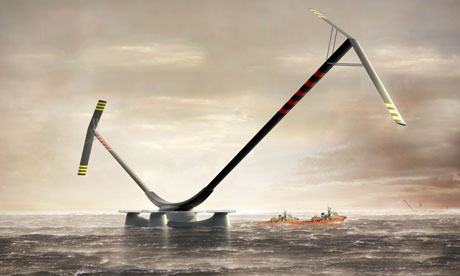Engineers race to design world's biggest offshore wind turbines
Posted by Big Gav in arup, offshore wind power, wind power
The Guardian has an article on a new British design for offshore wind turbines with a 275m wingspan that produce three times power of standard models - Engineers race to design world's biggest offshore wind turbines.
British, American and Norwegian engineers are in a race to design and build the holy grail of wind turbines – giant, 10MW offshore machines twice the size and power of anything seen before – that could transform the global energy market because of their economies of scale.
Today, a revolutionary British design that mimics a spinning sycamore leaf and which was inspired by floating oil platform technology, entered the race. Leading engineering firm Arup is to work with an academic consortium backed by blue-chip companies including Rolls Royce, Shell and BP to create detailed designs for the "Aerogenerator", a machine that rotates on its axis and would stretch nearly 275m from blade tip to tip. It is thought that the first machines will be built in 2013-14 following two years of testing.
But the all-British team of designers and engineers, which includes Eden project architects Grimshaw, is in stiff competition with other groups. Earlier this year US wind company Clipper, which has close ties with the US Department of Energy's National Renewable Energy Laboratory, announced plans to build 10MW "Britannia" turbines in north-east England.
Based on a scaled-up version of the conventional wind turbines now common in the British landscape, these giants would be fixed to the sea bed but would stand nearly 600ft high above the waves. If they prove technically and financially feasible, each turbine should be able to generate enough electricity to provide 5,000-10,000 homes and, says Clipper, should create energy equivalent to 2m barrels of oil in their 25-year lifetime.
Meanwhile, Norwegian firm Sway is planning to build massive floating turbines that would stick straight out of the sea from 100m-deep floating "masts" anchored to the sea bed. An EU-sponsored research project is also investigating 8–10MW turbines, and other American and Danish companies are planning 9MW machines. Full-scale prototyes of all three leading designs are expected to be complete within three years.
"There is a wonderful race on. It's very tight and the prize is domination of the global offshore wind energy market," said Feargal Brennan, head of offshore engineering at Cranfield University, where much of the Aerogenerator development work has been carried out.
"The UK has come late to the race, but with 40 years of oil and gas experience we have the chance to lead the world. The new [Aero-generator] turbine is based on semi-submersible oil platform technology and does not have the same weight constraints as a normal wind turbine. The radical new design is half the height of an equivalent [conventional] turbine," he said. He added that the design could be expanded to produce turbines that generated 20MW or more.






